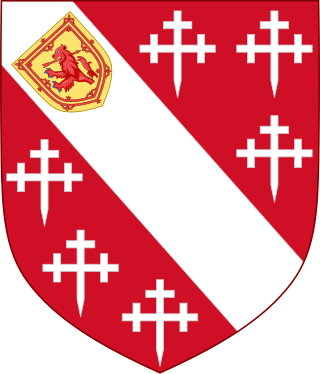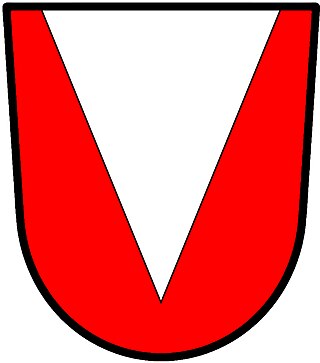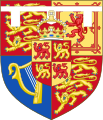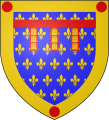
Earl Mountbatten of Burma is a title in the Peerage of the United Kingdom. It was created on 28 October 1947 for Rear Admiral Louis Mountbatten, 1st Viscount Mountbatten of Burma. The letters patent creating the title specified the following remainder in the absence of heirs male:
...to his eldest daughter Patricia Edwina Victoria, Baroness Brabourne...and the heirs male of her body lawfully begotten; and in default of such issue to every other daughter lawfully begotten of the said Louis Francis Albert Victor Nicholas, Viscount Mountbatten of Burma, successively in order of seniority of age and priority of birth and to the heirs male of their bodies lawfully begotten...

Duke of Fife is a title in the Peerage of the United Kingdom that has been created twice, in both cases for Alexander Duff, 1st Earl of Fife. In 1889, Lord Fife married Princess Louise, the eldest daughter of Albert Edward, Prince of Wales and a granddaughter of Queen Victoria.

Tincture is the limited palette of colours and patterns used in heraldry. The need to define, depict, and correctly blazon the various tinctures is one of the most important aspects of heraldic art and design.

In heraldry, variations of the field are any of a number of ways that a field may be covered with a pattern, rather than a flat tincture or a simple division of the field.
Ordinaries in heraldry are sometimes embellished with stripes of colour alongside them, have lumps added to them, shown with their edges arciform instead of straight, have their peaks and tops chopped off, pushed up and down out of the usual positions, or even broken apart.

The Howard family is an English noble family founded by John Howard, who was created Duke of Norfolk by King Richard III of England in 1483. However, John was also the eldest grandson of the 1st Duke of the first creation. The Howards have been part of the peerage since the 15th century and remain both the Premier Dukes and Earls of the Realm in the Peerage of England, acting as Earl Marshal of England. After the English Reformation, many Howards remained steadfast in their Catholic faith as the most high-profile recusant family; two members, Philip Howard, 13th Earl of Arundel, and William Howard, 1st Viscount Stafford, are regarded as martyrs: a saint and a blessed respectively.

In heraldry, cadency is any systematic way to distinguish arms displayed by descendants of the holder of a coat of arms when those family members have not been granted arms in their own right. Cadency is necessary in heraldic systems in which a given design may be owned by only one person at any time, generally the head of the senior line of a particular family.

In heraldry, an ordinary is one of the two main types of charges, beside the mobile charges. An ordinary is a simple geometrical figure, bounded by straight lines and running from side to side or top to bottom of the shield. There are also some geometric charges known as subordinaries, which have been given lesser status by some heraldic writers, though most have been in use as long as the traditional ordinaries. Diminutives of ordinaries and some subordinaries are charges of the same shape, though thinner. Most of the ordinaries are theoretically said to occupy one-third of the shield; but this is rarely observed in practice, except when the ordinary is the only charge.

In heraldry, an augmentation is a modification or addition to a coat of arms, typically given by a monarch as either a mere mark of favour, or a reward or recognition for some meritorious act. The grants of entire new coats by monarchs as a reward are not augmentations, but rather grants of arms, and an augmentation mistakenly given to someone who did not have a right to a coat would be nugatory.

The rule of tincture is a design philosophy found in some heraldic traditions that states "metal should not be put on metal, nor colour on colour". Heraldic furs such as ermine and vair, and charges described as "proper", are generally exempt from the rule of tincture.

Portuguese heraldry encompasses the modern and historic traditions of heraldry in Portugal and the Portuguese Empire. Portuguese heraldry is part of the larger Iberian tradition of heraldry, one of the major schools of heraldic tradition, and grants coats of arms to individuals, cities, Portuguese colonies, and other institutions. Heraldry has been practiced in Portugal at least since the 12th century, however it only became standardized and popularized in the 16th century, during the reign of King Manuel I of Portugal, who created the first heraldic ordinances in the country. Like in other Iberian heraldic traditions, the use of quartering and augmentations of honor is highly representative of Portuguese heraldry, but unlike in any other Iberian traditions, the use of heraldic crests is highly popular.

In heraldry, an ordinary componée, anglicised to compony and gobony, is composed of a row of squares, rectangles or other quadrilaterals, of alternating tinctures, often found as a bordure, most notably in the arms of the English House of Beaufort.

King Edward III of England and his wife, Philippa of Hainault, had eight sons and five daughters. The Wars of the Roses were fought between the different factions of Edward III's descendants. The following list outlines the genealogy supporting male heirs ascendant to the throne during the conflict, and the roles of their cousins. However to mobilise arms and wealth, significant major protagonists were Richard Neville, 16th Earl of Warwick, Edmund Beaufort, 4th Duke of Somerset, and Henry Percy, 3rd Earl of Northumberland, and their families. A less powerful but determining role was played by Humphrey Stafford, 1st Duke of Buckingham, and Elizabeth Woodville and their families.

In heraldry and heraldic vexillology, a blazon is a formal description of a coat of arms, flag or similar emblem, from which the reader can reconstruct the appropriate image. The verb to blazon means to create such a description. The visual depiction of a coat of arms or flag has traditionally had considerable latitude in design, but a verbal blazon specifies the essentially distinctive elements. A coat of arms or flag is therefore primarily defined not by a picture but rather by the wording of its blazon. Blazon is also the specialized language in which a blazon is written, and, as a verb, the act of writing such a description. Blazonry is the art, craft or practice of creating a blazon. The language employed in blazonry has its own vocabulary, grammar and syntax, which becomes essential for comprehension when blazoning a complex coat of arms.
Charles Stuart, Duke of Kendal was the third son of James, Duke of York and his first wife Anne Hyde.

In heraldry, a pile is a charge usually counted as one of the ordinaries. It consists of a wedge emerging from the upper edge of the shield and converging to a point near the base. If it touches the base, it is blazoned throughout.
Cornish heraldry is the form of coats of arms and other heraldic bearings and insignia used in Cornwall, United Kingdom. While similar to English, Scottish and Welsh heraldry, Cornish heraldry has its own distinctive features. Cornish heraldry typically makes use of the tinctures sable (black) and or (gold), and also uses certain creatures like Cornish choughs. It also uses the Cornish language extensively for mottoes and canting arms.
Heraldic labels are used to differentiate the personal coats of arms of members of the royal family of the United Kingdom from that of the monarch and from each other. In the Gallo-British heraldic tradition, cadency marks have been available to "difference" the arms of a son from those of his father, and the arms of brothers from each other, and traditionally this was often done when it was considered important for each man to have a distinctive individual coat of arms and/or to differentiate the arms of the head of a house from junior members of the family. This was especially important in the case of arms of sovereignty: to use the undifferenced arms of a kingdom is to assert a claim to the throne. Therefore, in the English royal family, cadency marks were used from the time of Henry III, typically a label or bordure alluding to the arms of the bearer's mother or wife. After about 1340, when Edward III made a claim to the throne of France, a blue label did not contrast sufficiently with the blue field of the French quarter of the royal arms; accordingly most royal cadets used labels argent: that of the heir apparent was plain, and all others were charged. Bordures of various tinctures continued to be used into the 15th century.
The Spanish monarchs of the House of Habsburg and Philip V used separate versions of their royal arms as sovereigns of the Kingdom of Naples-Sicily, Sardinia and the Duchy of Milan with the arms of these territories.

The coat of arms of the Prince of Wales is the official personal heraldic insignia of the Princes of Wales, a title traditionally granted to the heir apparent of the reigning monarch of the United Kingdom of Great Britain and Northern Ireland, formerly the Kingdom of Great Britain and before that the Kingdom of England.



























